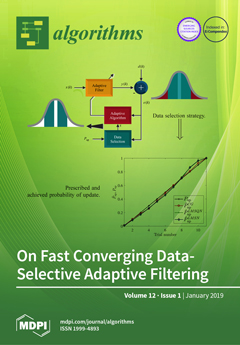Algorithms, Volume 12, Issue 1 (January 2019) – 27 articles
In many practical applications, the number of data-acquisition devices is growing at an exponential rate, such as in distributed networks, in massive multiple-input multiple-output (MIMO) antennas, and for social networks. This trend calls for the parsimonious use of the acquired data when considering the overwhelming resources required such as storage capacity.
In the era of Big Data, we face the challenge of efficiently utilizing a large amount of data to extract critical information.
In the context of adaptive filtering, the recently proposed strategy to perform data selection approximating a prescribed update rate appears to be promising. View this paper.
- Issues are regarded as officially published after their release is announced to the table of contents alert mailing list.
- You may sign up for e-mail alerts to receive table of contents of newly released issues.
- PDF is the official format for papers published in both, html and pdf forms. To view the papers in pdf format, click on the "PDF Full-text" link, and use the free Adobe Reader to open them.





